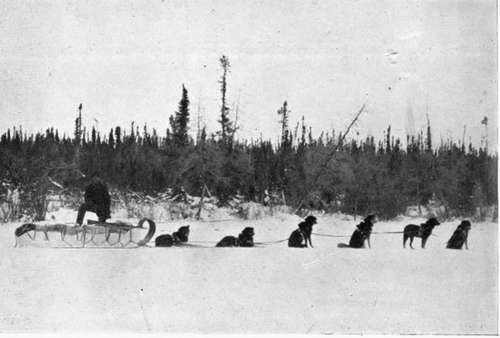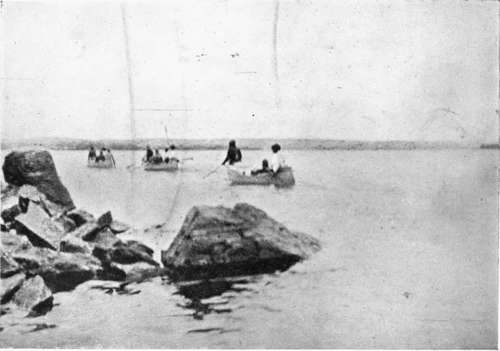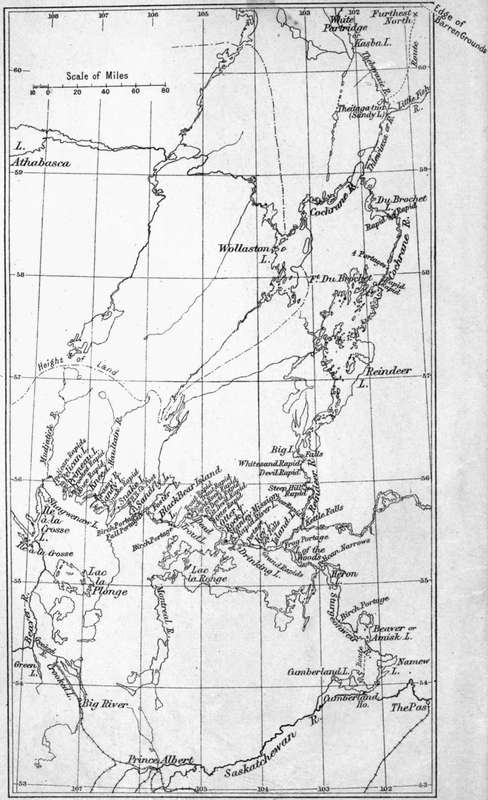Preface
Description
This section is from the book "Wild Life In Canada", by Angus Buchanan. Also available from Amazon: Wild Life in Canada.
Preface
So great is the far north territory that there is many a hundred miles on which no white man has yet set foot, and even where the white man has been, in the distant interior near to the Barren Lands, in many cases the footprints have been so few that an old Indian inhabitant of a district could easily count those who had passed in a lifetime on his ten fingers.
Though I travelled 785 miles over ice and snow by dog-sled, and 1,044 miles over water in a single canoe, I lay no claim to having done a great thing, for in face of the rigorous, boundless North a single man's effort must ever seem small.
Again and again I might go back to the solitude of the Great North-and perhaps I will-but I know full well I will always deem the hours of a lifetime all too short to accomplish half that I would wish in that overwhelming vastness that reminds me, with a sternly intimidating dominance, that I am but a tiny, passing atom, active for the moment, but woefully impotent before the timeless reign of the brooding wilderness.
Yet, piece by piece, the character of a new land is revealed, not by the endeavour of one man or one generation, but at the instance of many, and so if the long trails I have made seem little in proportion to the limitless extent that lay before me, I still trust that my investigation of a country lying between the Saskatchewan River and the Arctic Barren Grounds, and between longitudes 101° and 108°, may add in some measure to man's knowledge of that territory, whether the reader of this narrative be layman with a love of nature, or naturalist who finds delight in following the endeavours of an associate.
In a scientific article recently prepared for publication by J. H. Fleming, C.M.Z.S., C.M.B.O.U., a notable Canadian ornithologist, dealing with the bird life which I collected on this expedition, the writer says :
" Almost the first knowledge we have of the ornithology of the Saskatchewan region is contained in a series of papers published in the Ibis of 1861-62-63, by Capt. Blakiston, who spent the winter of 1857-58 at Fort Carlton on the Saskatchewan River, and in 1858 collected at various points in what is now the Province of Saskatchewan. In these papers Capt. Blakiston incorporated much information from Vol. II of the Fauna Boreali-Americana of Richardson and Swainson, and other published sources of information. Since then our knowledge of the birds of Southern Saskatchewan has been considerably enlarged, but strangely enough the ornithology of the great region drained by the Churchill River, and lying to the north of what was, till 1912, the northern boundary of the province, has had little or no attention paid to it. Notes on the birds were made by James M. Macoun, who in 1888 travelled from Lesser Slave Lake east by way of the Athabasca and Churchill Rivers to Lake -Winnipeg; these notes were eventually published by John Macoun in his Catalogue of Canadian Birds. Less than a dozen birds are in the United States National Museum, collected at Du Brochet Lake in 1890 and Pelican Narrows on the Churchill River in 1891 ; probably collected by Henry MacKay and Joseph Hourston, for Roderick MacFarlane. These are the only skins I have seen from the region taken previous to 1914. During the years 1892-93-94, J. Burr Tyrrell, in the course of his explorations of the Barren Grounds, more than once traversed the Churchill River and his official reports 1 contain the best description we have of this region; in these reports there are short references to birds. When Edward A. Preble wrote his great report on the natural history of the Athabasca-Mackenzie Region1 he included all that was known of the birds of the Churchill River up to 1908.
1 Annual Report Geological Survey of Canada, viii. (new series), Part D, pp. 5d to 120d, Ottawa, 1896; ibid. ix. 1896, Part F (1897).
" When the boundaries of Saskatchewan were in 1912 extended north to include a part of the old North-West Territory, so little was known by the Provincial Government of the natural history of the northern part of the country that Angus Buchanan determined to investigate the country lying between the Saskatchewan River and the Barren Grounds. He left Prince Albert on May 6, 1914, and descended the Beaver River to Lake lie a la Crosse, and the Churchill River, thence continuing upstream on Reindeer River and Reindeer Lake, entering the Cochrane River on July 18, and Lake Du Brochet on August 1. His base camp was made north of this lake, and here he proposed to winter, but hearing of the outbreak of the war in late October he decided to return to the South, and reached Regina on January 15, 1915, after an absence of eight and a half months, during which he travelled nearly two thousand miles by canoe and dog-sleigh. The birds collected during this expedition were divided; part were deposited in the Provincial Museum at Regina, and the rest were handed over to me ; they form a very important addition to our knowledge of the birds of the region drained by the Churchill River, and are in fact the first collection made in far Northern Saskatchewan."

Winter On The Trail

Summer On The Trail
1 A Biological Investigation of the Athabasca-Mackenzie Region. North American Fauna, No. 27. Bureau of Biological Survey, Washington, 1908.
It may seem odd to the reader that I make record at this date of an expedition undertaken in the year 1914, yet this may be easily explained, and, I hope, the delay forgiven, as such a circumstance is entirely due to the exigencies of the Great War, during which it was every able man's duty to abandon civil occupation and take up arms in defence of home and country, even though such action would rudely shake, and perhaps break, the foundation of almost any career. On receiving my release from the Army I have made haste to return to the full pages of my diary of 1914 and to labour to record my experiences of that time in the hope that they might be in some measure instructive to those setting forth on like adventure, and to those who take an interest in wild life of any kind. Moreover, whatever I experienced in 1914 of the country I then travelled through still retains the native novelty, for had other footsteps followed mine I would have been told so by the Government authorities with whom I remain in correspondence. So, through the years of war that have passed, the North remains the silent, unbounded solitude that my canoe and dog-sled intruded on for a brief space ; since then no like expedition has passed along that pathless route.
Every traveller appreciates or depreciates his reception by the inhabitants of the country he travels through, and, in this instance I owed much to the good services of the Saskatchewan Provincial Government, who loyally supported the expedition at the start; to the Hudson Bay Company, whose factors were ever ready to assist and advise me in every way they could; and lastly, though I say it of people who cannot read and know my appreciation, to the Cree and Chipewyan Indians, who proved quaintly friendly and unselfish in their hospitality, and resourceful, magnificent fellow-travellers on the trail on the few occasions that I came among them, and when one or more aided me when trailing by dog-train over ice and snow. To all I owe the thanks and gratitude of a traveller safely returned from a hazardous quest who enjoys pleasant reminiscences of the weather-beaten, kindly faces of worthy outdoor people, and still recalls their strong handshake of genuine comradeship that on many a hard trail welcomed me in, or pointed the way forth with well-wishing.

Continue to:
